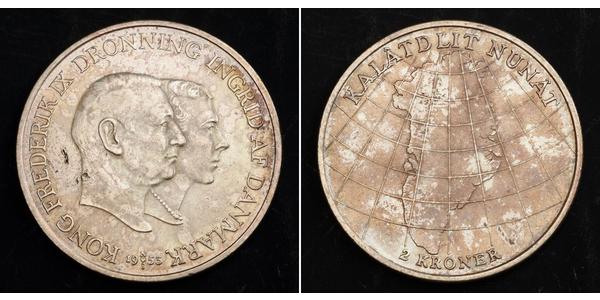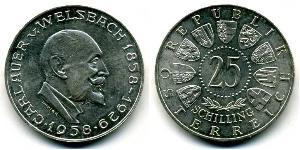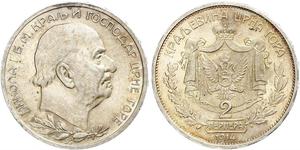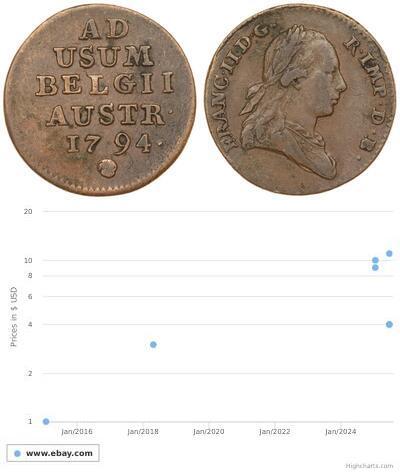1953, Denmark, Frederick IX. Silver 2 Kroner "Greenland Commemorative" Coin.
Mint Year: 1953 Reference: KM-844. Mint Place: Copenhagen (heart) Condition: Digs/hits (old silver-test?) in left field, light toning, otherwise AU! Denomination: 2 Kroner - Foundation for the Campaign against Tuberculosis in Greenland Material: Silver (.800) Weight: 15.07gm Diameter: 31mm
Obverse: Conjoined heads of Frederick IX and Queen Ingrid right. Legend: FREDERIK IX KONGE AF DANMARK 19 (N / privy mark: heart / S) 53 Reverse: Map of Greenland with Maridians. Value (2 KRONER) below. Legend: KALATDLIT NUNAT
Greenland (Danish: Grønland) is an autonomous constituent country of the Kingdom of Denmark between the Arctic and AtlanticOceans, east of the Canadian Arctic Archipelago. Though physiographically a part of the continent of North America, Greenland has been politically and culturally associated with Europe (specifically Norway and Denmark, the colonial powers, as well as the nearby island of Iceland) for more than a millennium. The majority of its residents are Inuit, whose ancestors began migrating from the Canadian mainland in the 13th century, gradually settling across the island.
em>.
Frederick IX (Christian Frederik Franz Michael Carl Valdemar Georg) (11 March 1899 – 14 January 1972) was King of Denmark from 20 April 1947 until his death. He was the son of King Christian X of Denmark and Queen Alexandrine, born Duchess of Mecklenburg.
Frederik was born in Sorgenfri on Zealand and was educated at the Royal Danish Naval Academy (breaking Danish royal tradition by choosing a naval instead of an army career) and the University of Copenhagen. Before he became king, he had acquired the rank of Rear Admiral and he had had several senior commands on active service. In addition, with his great love of music, the king was an able piano player and conductor.
In 1922, Frederick was engaged to Princess Olga of Greece and Denmark, his cousin and the daughter of Prince Nicholas of Greece and Denmark; however they never wed. Instead, he married Princess Ingrid of Sweden (1910–2000), daughter of Crown Prince Gustaf Adolf, later King Gustaf VI Adolf of Sweden, in Stockholm on 24 May 1935. They were related in several ways. In descent from Oscar I of Sweden, they were third cousins. In descent from Paul I of Russia, Frederick was a fourth cousin of Ingrid's mother. They had three daughters:
- Princess Margrethe Alexandrine Þórhildur Ingrid (born 1940), later Queen Margrethe II of Denmark, who married French Count Henri de Laborde de Monpezat, who was created Prince Henrik of Denmark, in 1967.
- Princess Benedikte Astrid Ingeborg Ingrid (born 1944), who married Prince Richard of Sayn-Wittgenstein-Berleburg in 1968.
- Princess Anne-Marie Dagmar Ingrid (born 1946), who married King Constantine II of the Hellenes in 1964.
When he had no sons, it was expected that his younger brother Knud would inherit the throne, in accordance with Denmark's succession law (Royal Ordinance of 1853). However, in 1953, an Act of Succession was passed, changing the method of succession to cognatic primogeniture, meaning that his eldest daughter, Margrethe, could succeed if he had no sons, which she did, as Queen Margrethe II. By order of 27 March 1953 the succession to the throne was limited to the issue of King Christian X.
Frederick's reign saw great change. During these years, Danish society shook off the restrictions of an agricultural society and developed a welfare state. And, as a consequence of the booming economy of the 1960s, women entered the labour market. In other words, Denmark became a modern country, which meant new demands on the monarchy.
He was the 912th Knight of the Order of the Garter in 1951.
Shortly after the king had delivered his New Year's Address to the Nation at the 1971/72 turn of the year, he fell ill. On his passing in Copenhagen in 1972, King Frederick IX was buried outside Roskilde Cathedral near Copenhagen. Previous rulers had been interred in the cathedral, but it was the King's wish to be buried outside.

|
Posted by:
anonymous 2018-11-23 |
44 coins were grouped from 2025-05-28 to 2025-06-04
One of them is:
1 Ruble Russian Empire (1720-1917) Silver
group has 12 coins / 12 prices
⇑
















-300-150-72sKbzbis7EAAAFPBUQ1Mk0C.jpg)
-300-150-9UEKbzbiU5UAAAFQcX3krksT.jpg)





